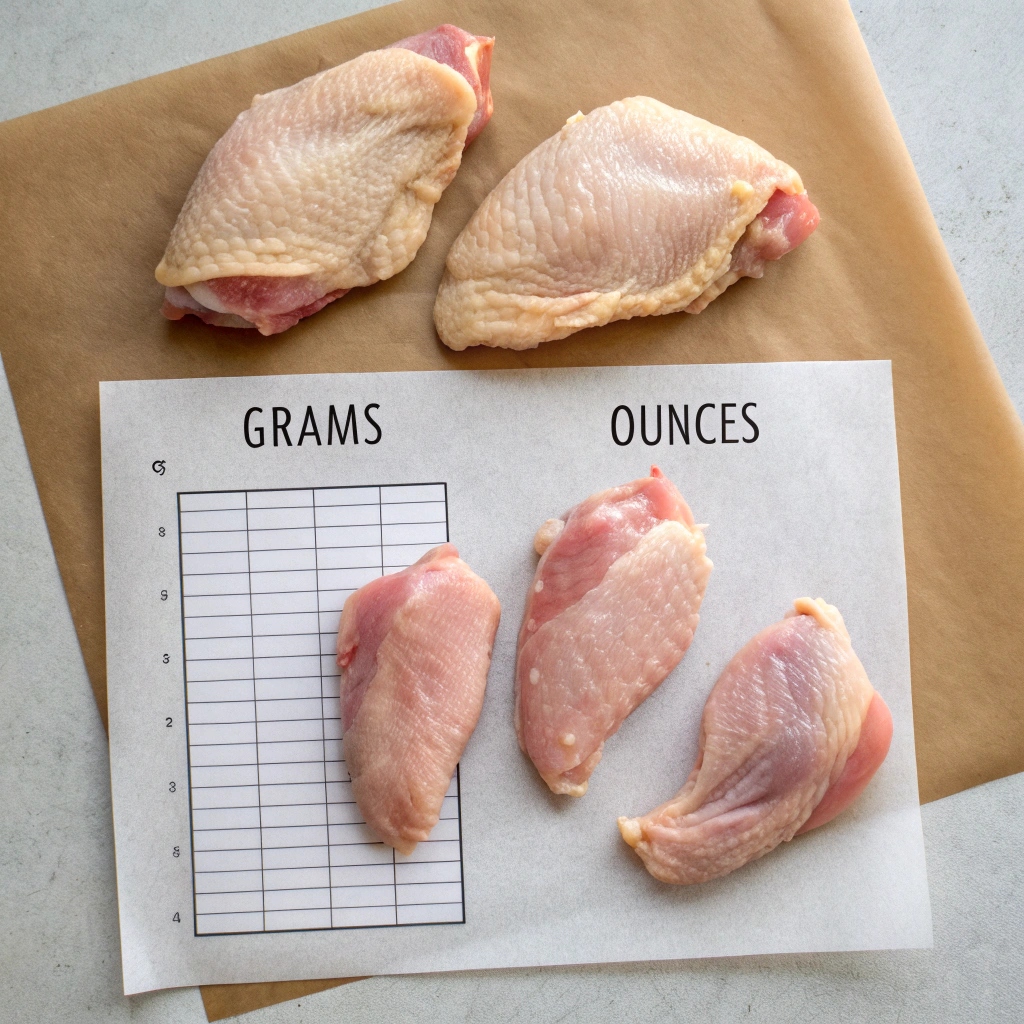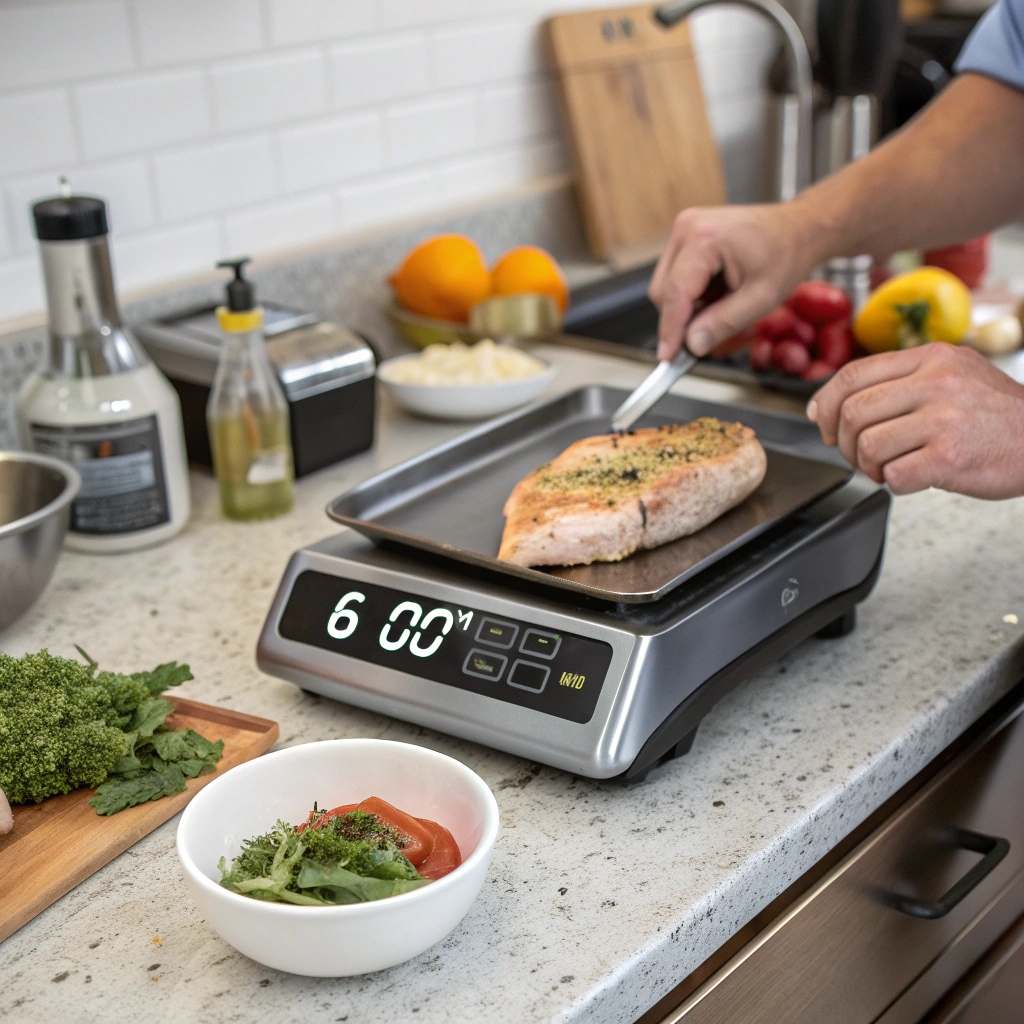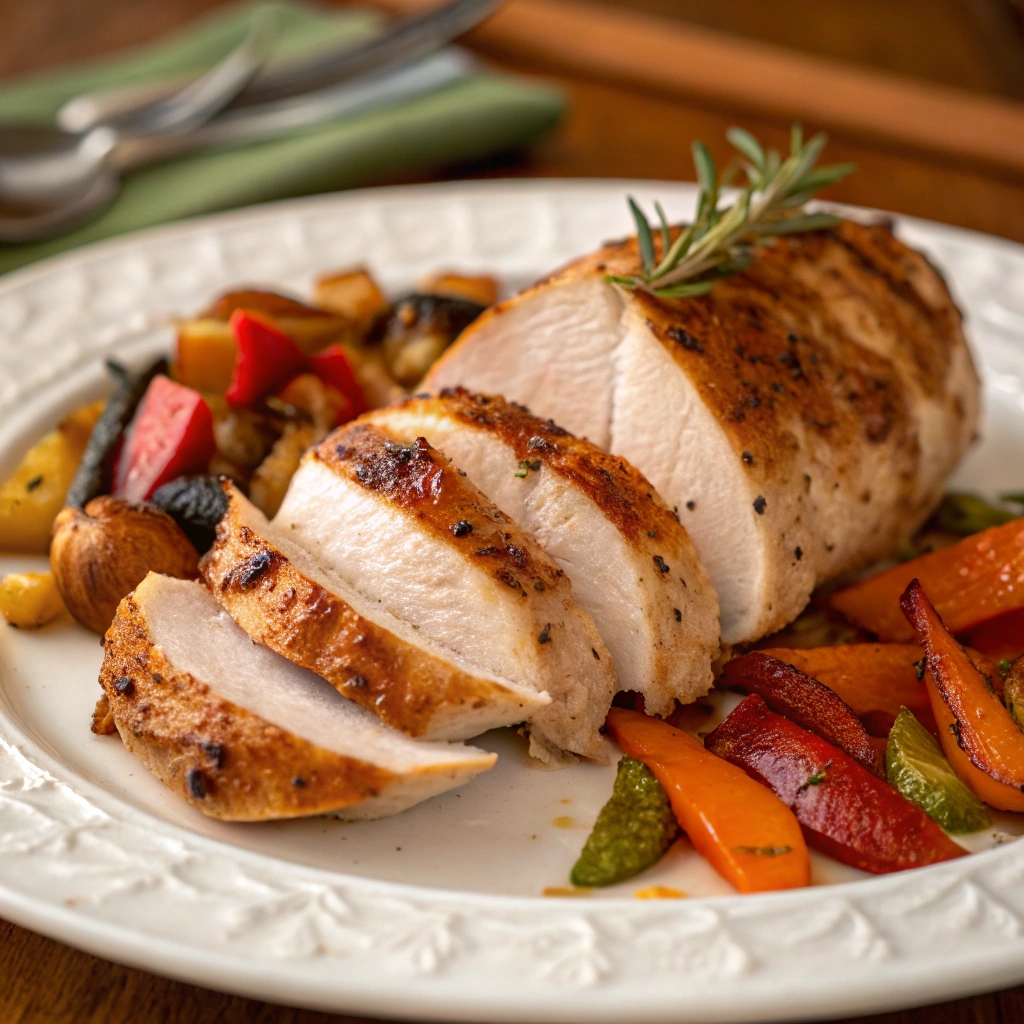Ever wondered why chicken breast weight is such a big deal? 🤔 It’s not just for chefs or nutritionists—it’s something we all need to think about when cooking, meal prepping, or even tracking our calories. Knowing how much a chicken breast weighs can help you make better decisions in the kitchen. Whether you’re counting calories for a fitness goal or simply trying to perfect that recipe, understanding chicken breast weight is key.
Table of Contents
What Is a Chicken Breast?
Okay, let’s start with the basics. A chicken breast is the meaty part of a chicken located on its chest. Typically, when people buy chicken breast from the store, it’s sold skinless and boneless. These are the most convenient to cook and measure. You can also find chicken breasts with the skin on or with the rib bones attached, but these are less common for everyday cooking.
Chicken breasts are a favorite because they’re lean, packed with protein, and super versatile. You can grill, bake, fry, or boil them—they’re basically the Swiss Army knife of the protein world. 🐔
Anatomy of a Chicken Breast
To better understand its weight, let’s look at its anatomy:
- Skinless and Boneless: The pure meat, ready to cook. This is what most recipes and calorie counts refer to.
- With Skin: Adds flavor and moisture, but also extra weight and fat.
- With Bone: Slightly heavier due to the bone, which usually makes up about 20% of the total weight.
When you’re considering weight, these differences matter. A bone-in, skin-on chicken breast will weigh more than a skinless, boneless one.
Average Weight of a Chicken Breast
The weight of a chicken breast can vary depending on its size, the type of chicken it comes from, and whether it’s raw or cooked. Let’s break it down:
- Raw Chicken Breast Weight: A raw, boneless, skinless chicken breast typically weighs between 6 to 8 ounces (170 to 227 grams). Larger chicken breasts can weigh up to 10 or even 12 ounces.
- Cooked Chicken Breast Weight: After cooking, chicken breasts lose about 20-25% of their weight due to water loss. For example, an 8-ounce raw breast will weigh around 6 ounces (170 grams) once cooked.
Here’s a simple table for quick reference:
| Type | Weight (Average) |
|---|---|
| Raw, Skinless, Boneless | 6–8 oz (170–227 g) |
| Raw, Bone-In | 10–12 oz (283–340 g) |
| Cooked, Skinless | 4.5–6 oz (128–170 g) |

Factors That Affect Chicken Breast Weight
Now, why does the weight vary so much? It’s not random—several factors come into play.
- Size Variations in Commercial Chicken Breasts:
Nowadays, chickens are bred to be larger than they were decades ago. This means the average chicken breast size has increased over time. You might find some shockingly large ones in your supermarket! - Organic vs. Conventional Chicken Breasts:
Organic chickens are often smaller because they aren’t treated with growth hormones or antibiotics. This means their breasts tend to be lighter. - Fresh vs. Frozen:
Frozen chicken breasts often come with added water or brine to preserve freshness. This increases their weight but doesn’t add actual meat.
Why Does Chicken Breast Weight Vary?
Let’s think about it like buying a loaf of bread. Some are dense and heavy, while others are fluffy and light. Chicken breasts are kind of like that. Their weight depends on how they’re raised and processed.
- Breeding and Farming Practices: Chickens bred for commercial purposes are larger, and so are their breasts. Free-range or organic chickens are smaller, leading to lighter breasts.
- Processing Methods: Some chicken breasts are injected with a saline solution to keep them moist, which can increase the weight artificially.
Why Is This Important for Recipes?
Imagine making a recipe that calls for two chicken breasts. If you use two large ones weighing 12 ounces each, but the recipe was designed for 6-ounce breasts, your cooking time and portion sizes will be way off. Ever ended up with dry, rubbery chicken? This might be why.
Measuring Chicken Breast Weight: Tools and Techniques
So, how do you figure out how much a chicken breast weighs? Here are some tips:
- Use a Kitchen Scale:
A kitchen scale is your best friend. Just place the chicken breast on the scale (raw or cooked) and note the weight. Easy-peasy. - Estimate Without a Scale:
No scale? No problem. A raw chicken breast roughly the size of your palm (excluding fingers) usually weighs around 6–8 ounces. - Cut and Portion:
If your recipe calls for specific weights, don’t be afraid to cut the breast into smaller portions. This ensures even cooking and better portion control.
Common Problems When Dealing With Chicken Breast Weight
Let’s be real: cooking chicken breasts isn’t always smooth sailing. From uneven sizes to portion control, there are a few hiccups you might run into. Don’t worry; we’ll tackle these one by one.
1. Uneven Sizes in a Pack
Ever opened a pack of chicken breasts and found one giant piece next to a tiny one? It’s frustrating, right? This happens because chicken breasts naturally vary in size, and processing doesn’t always sort them uniformly.
- Problem: Uneven pieces cook at different rates, leaving you with some parts overcooked and others undercooked.
- Solution: Flatten them with a meat mallet or rolling pin to even out the thickness. If one breast is significantly larger, consider cutting it into smaller portions.
2. Challenges in Portion Control
When you’re trying to stick to a diet or meal prep, guessing the weight of a chicken breast can lead to inconsistent portions.
- Problem: You might eat more calories or protein than intended.
- Solution: Use a kitchen scale to weigh each portion. If you don’t have a scale, remember the palm rule: one average chicken breast (6–8 ounces) is about the size of your palm.
- Problem: Larger chicken breasts take longer to cook, and misjudging the size means you’ll overcook the smaller ones.
- Solution: Always check the internal temperature with a meat thermometer. Chicken is perfectly cooked at 165°F (74°C).
Solutions and Tips for Managing Chicken Breast Weight
Now that we’ve addressed the problems, let’s talk about practical solutions and tips to make your life easier:
1. Portion Control Tips
Managing portions doesn’t have to feel like rocket science.
- Trim Before Cooking: Remove any extra fat or uneven edges. This not only makes the breast lighter but also ensures it cooks evenly.
- Slice Before Serving: If you have a large chicken breast, slice it into smaller pieces for easy serving. This way, everyone gets an even portion.
2. How to Trim and Prep Chicken Breasts
Want your chicken to look like it came straight out of a chef’s kitchen? Prepping is key.
- Remove the Tendon: That white, stringy tendon in the breast? It’s tough and unpleasant to eat. Hold it with a fork and pull it out with a knife.
- Flatten for Even Cooking: Use a meat mallet or rolling pin to pound the breast into an even thickness. Place it between two sheets of plastic wrap to keep things tidy.
Chicken Breast Weight in Popular Recipes
Let’s face it, recipes don’t always specify the size of the chicken breast they’re referring to. This can leave you guessing and potentially ruin your dish.
1. How Weight Impacts Cooking Time
Cooking time largely depends on the weight and thickness of the chicken breast.
- Small Chicken Breast (6 ounces): Takes about 20–25 minutes at 400°F (204°C) in the oven or 7–8 minutes per side on medium heat if pan-frying.
- Large Chicken Breast (10 ounces): Takes closer to 30–35 minutes at 400°F (204°C) or 10–12 minutes per side on the stovetop.
2. Adjusting Recipes Based on Chicken Breast Size
If you’re working with larger breasts than the recipe calls for, you might need to adjust the cooking time.
- Tip: If you’re doubling the size, reduce the heat slightly and cook for longer. This prevents the outside from overcooking while the inside cooks through.
A Quick Nutritional Table for Chicken Breast
Here’s a handy table showing the nutrition for a typical raw, skinless, boneless chicken breast (4 ounces or 113 grams):
| Nutrient | Amount |
|---|---|
| Calories | 120 kcal |
| Protein | 26 grams |
| Fat | 2 grams |
| Carbohydrates | 0 grams |
| Cholesterol | 70 mg |
| Sodium | 60 mg |
Want to customize your intake? Just multiply the values based on the weight of your chicken breast. For example, an 8-ounce breast will have double these values.
Why Chicken Breast Weight Matters for Nutrition
When it comes to nutrition, the weight of your chicken breast directly impacts your calorie and protein intake. For fitness enthusiasts, every gram counts.
- Protein Goals: A 6-ounce chicken breast provides about 42 grams of protein, which is perfect for muscle repair and growth.
- Calorie Management: If you’re watching your weight, measuring the breast ensures you’re not accidentally eating more calories than intended.

Frequently Asked Questions About Chicken Breast Weight
Let’s clear up some of the most common questions people have about chicken breast weight. If you’ve ever been curious about how weight changes during cooking or what serving sizes really mean, this section is for you!
1. What Is the Ideal Serving Size for a Chicken Breast?
A typical serving size of chicken breast is around 3 to 4 ounces (85 to 113 grams). This is roughly the size of a deck of cards or the palm of your hand.
However, the actual serving size might vary depending on your nutritional needs:
- For Muscle Gain: You might aim for a larger portion, around 6 to 8 ounces, to hit your protein goals.
- For Weight Loss: Stick to the recommended 3 to 4 ounces to control calories and fat intake.
2. How Much Does a Chicken Breast Weigh After Cooking?
Chicken breasts lose about 20–25% of their weight during cooking due to water loss. So, if you start with an 8-ounce (227-gram) raw chicken breast, it will weigh about 6 ounces (170 grams) after cooking.
- Fun Tip: If you need a specific cooked weight, you can calculate backward. For example, if you want 4 ounces of cooked chicken, start with about 5 to 5.5 ounces of raw chicken.
How Weight Impacts Cooking and Nutrition
Let’s think of chicken breasts as the star ingredient in your meal. Getting their weight right ensures your dish is delicious, nutritious, and just the right portion size.
1. Cooking Adjustments Based on Weight
Cooking time and temperature need to align with the size of the chicken breast. Here’s a handy guide:
| Weight | Cooking Method | Time |
|---|---|---|
| 6 oz | Pan-Frying | 7–8 mins per side on medium |
| 8 oz | Baking (400°F/204°C) | 22–25 minutes |
| 10 oz | Grilling (Medium Heat) | 10–12 minutes per side |
2. Nutrition in Different Weights
A larger chicken breast naturally has more calories and protein. Here’s a breakdown for a boneless, skinless chicken breast:
| Weight | Calories | Protein | Fat |
|---|---|---|---|
| 4 oz (113 g) | 120 kcal | 26 g | 2 g |
| 6 oz (170 g) | 180 kcal | 39 g | 3 g |
| 8 oz (227 g) | 240 kcal | 52 g | 4 g |
Creative Cooking Tips for Chicken Breasts
Tired of boring chicken dishes? Here are some ways to spice things up:
1. Marinades Make All the Difference
A good marinade can elevate your chicken breast from bland to mouthwatering.
- Quick Marinade Recipe: Combine olive oil, lemon juice, garlic, paprika, salt, and pepper. Let the chicken sit for at least 30 minutes.
2. Slice for Even Cooking
Butterflying or slicing chicken breasts into thinner pieces not only reduces cooking time but also ensures even seasoning.
3. Rest Before Serving
Let the chicken rest for about 5 minutes after cooking. This locks in the juices and makes every bite tender and flavorful.
4. Add Veggies for a Complete Meal
Pair chicken breast with roasted vegetables or a fresh salad for a well-rounded, nutritious meal. Think vibrant bell peppers, zucchini, or a simple spinach side.
Block Quote Inspiration
“Perfectly cooked chicken breasts aren’t about luck—they’re about knowing the weight, choosing the right method, and nailing the timing.”
Mastering the Art of Cooking Chicken Breasts
As we wrap up this guide, let’s focus on the small yet impactful tweaks you can make to ensure every chicken breast you cook is a hit. Whether you’re a seasoned home cook or just starting out, these strategies will make you a pro in no time.
More Solutions for Common Chicken Breast Challenges
1. Dealing with Dry Chicken Breasts
Dry chicken breasts can ruin an otherwise perfect meal. What’s the fix?
- Brine Before Cooking: Soak the chicken in a saltwater solution (1/4 cup of salt per quart of water) for 30 minutes to 2 hours. This locks in moisture and adds flavor.
- Don’t Overcook: Stick to the internal temperature of 165°F (74°C) and use a thermometer to avoid guesswork.
2. Adding Flavor Without Extra Calories
If you’re calorie-conscious, there are ways to enhance flavor without adding butter or heavy sauces:
- Use spices and herbs like garlic powder, paprika, rosemary, or thyme.
- Add a splash of citrus juice (lemon or lime) for brightness.
- Experiment with low-sodium soy sauce or balsamic vinegar for depth.
3. Getting Perfectly Even Cooking
Ever notice how the edges of a chicken breast cook faster than the middle? That’s because they’re thinner. To fix this:
- Pound the Breast: Flatten it using a rolling pin or mallet to ensure even thickness.
- Cook at Lower Heat: If you’re baking or grilling, opt for a slightly lower temperature for longer to ensure the inside is cooked without over-drying the outside.

Nutritional Benefits of Chicken Breasts
Chicken breasts are a nutritional powerhouse. If you’re aiming for a high-protein, low-fat diet, they’re unbeatable. Here’s why:
- Lean Protein: Great for muscle building and recovery.
- Low in Fat: A 4-ounce portion contains just 2 grams of fat, making it a heart-healthy choice.
- Rich in Vitamins: Packed with B vitamins (like B6 and niacin) that support energy metabolism.
Block Quote Highlight:
“Think of chicken breasts as the blank canvas of the culinary world—simple, versatile, and waiting to be transformed into something amazing.”
Frequently Asked Chicken Breast Cooking Tips
1. Should You Season Before or After Cooking?
Season before cooking to infuse the meat with flavor. Salt draws out moisture, so avoid seasoning too far in advance (unless brining).
2. Can You Cook Chicken Breast Straight from Frozen?
Yes, but it takes longer and requires careful handling. Bake at 375°F (190°C) for about 45–60 minutes, depending on size. Use a thermometer to ensure the inside reaches 165°F (74°C).
3. How Do You Store Leftover Chicken Breasts?
Store cooked chicken in an airtight container in the fridge for up to 3 days. To reheat, add a splash of water or broth and microwave covered to retain moisture.
Practical Table: Chicken Breast Weight vs. Cooking Time
Here’s a practical cheat sheet for cooking chicken breasts based on weight and method:
| Weight (Raw) | Cooking Method | Temperature | Time |
|---|---|---|---|
| 6 oz (170 g) | Baking | 400°F (204°C) | 20–25 minutes |
| 8 oz (227 g) | Grilling | Medium Heat | 8–10 minutes per side |
| 10 oz (283 g) | Pan-Frying | Medium Heat | 12–14 minutes total |
Tips for Meal Prepping with Chicken Breasts
Meal prepping can save time and help you stay on track with your nutrition goals. Here’s how to make chicken breasts a meal-prep superstar:
- Batch Cook: Bake or grill multiple breasts at once and store them in individual portions.
- Use Different Flavors: Divide your batch and season each portion differently (e.g., BBQ, lemon herb, spicy paprika) to keep things exciting.
- Freeze for Later: If you won’t use them within 3 days, freeze cooked chicken in meal-sized portions.
More Ideas for Exploring Related Content
Looking for more inspiration or related topics to expand your culinary knowledge? Here are some fantastic ideas, complete with internal links to deepen your understanding and provide additional value.
1. Chicken Recipes and Cooking Techniques
- Chicken Meets Pasta: How to Nail One Pan: Discover how to combine chicken and pasta in a single pan for a quick, flavorful dinner. Perfect for busy weeknights!
- Secrets to Making the Best Rotisserie Chicken Pasta: Elevate your pasta dishes with rotisserie chicken, and learn how to infuse flavors seamlessly.
- What to Do with Overcooked Chicken Thighs: Save Your Meal: Don’t toss overcooked chicken! Learn creative ways to save your dish with these simple tips.
2. Salad and Side Dish Ideas
- Chicken Bacon Ranch Pasta Salad: A Perfect Blend of Flavors: A creamy, savory pasta salad that pairs beautifully with grilled chicken breasts.
- What Is Chicken Salad Chick Made Of?: Learn what goes into the famous Chicken Salad Chick recipe and how to recreate it at home.
- Can You Eat Cold Pasta and Chicken?: Get answers to common questions about storing and enjoying pasta and chicken safely.
3. Meal Prep and Breakfast Options
- Microwaving Frozen Breakfast Sandwiches: Learn the fastest, most efficient way to prepare frozen breakfast sandwiches without compromising taste.
- Step-by-Step: How to Cook a Delicious Jimmy Dean Breakfast Sandwich: A detailed guide to enjoying your breakfast sandwiches perfectly every time.
- Jimmy Dean Breakfast Sandwich Healthy? The Truth About Its Nutrition: Dive into the nutritional aspects of Jimmy Dean breakfast sandwiches and how to incorporate them into your meal plans.
4. Exploring Global Chicken Recipes
- Hmong Cuisine Spotlight: The Best Cabbage and Chicken Recipe: Explore Hmong-inspired cooking with this unique cabbage and chicken recipe.
- Why Are My Chicken Meatballs Spongy?: Troubleshoot and perfect your chicken meatballs with these expert tips.
- Chicken Ricotta Meatballs: A light and fluffy twist on traditional meatballs that pairs well with pasta or salads.
5. Quick Fixes and Practical Tips
- Quick Fixes for Dry Leftover Chicken: Recipes You’ll Love: Transform dry chicken leftovers into flavorful dishes with these creative ideas.
- How to Cook Ground Chicken: Easy Tips Everyone Can Try: Master ground chicken cooking techniques for burgers, meatballs, and more.
- How to Jazz Up Boring Pasta: Add some excitement to plain pasta dishes with these simple, flavorful tips.
Conclusion: Mastering Chicken Breast Weight and Cooking
So, how much does a chicken breast weigh? By now, you know it’s more than just a number on a scale. From understanding raw vs. cooked weights to adjusting recipes and mastering cooking techniques, you’re now equipped to handle any chicken breast challenge that comes your way.
Remember, whether you’re grilling, baking, or pan-frying, knowing the weight of your chicken breast ensures perfectly cooked, juicy, and flavorful results every time.
So the next time you’re in the kitchen, grab that chicken breast, measure it, and cook with confidence! 🐔✨
